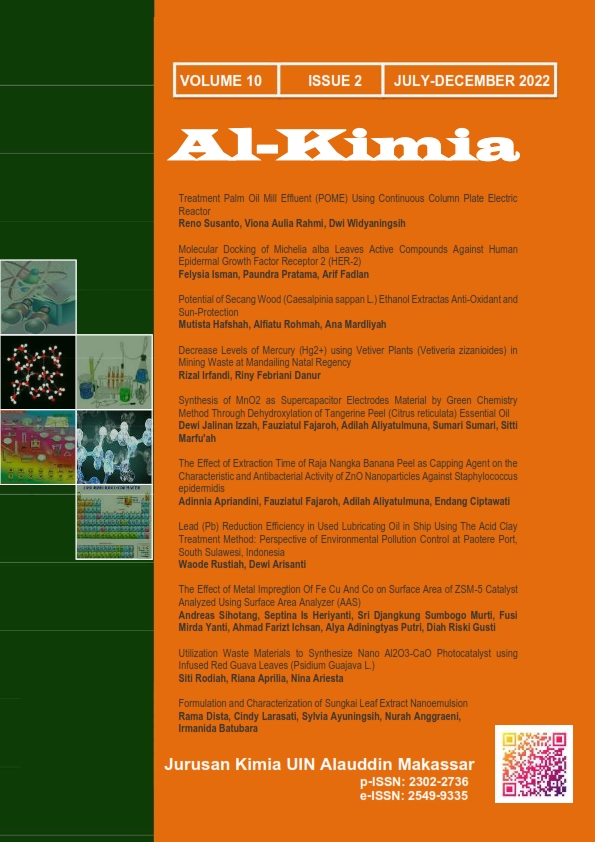Potential of Secang Wood (Caesalpinia sappan L.) Ethanol Extractas Anti-Oxidant and Sun-Protection
Abstract
Although sunlight has numerous health benefits, prolonged direct exposure to the sun can be harmful to the skin. Among the negative effects of sun exposure are redness and burning of the skin, as well as dullness, wrinkles, dryness, and premature aging, as well as skin cancer. The use of sunscreen to protect the skin from the harmful effects of prolonged sun exposure is becoming more widespread. On the other hand, some sunscreens contain potentially harmful chemicals such as isopropyl alcohol, DEA (diethanolamine), TEA (triethanolamine), and MEA (monoethanolamine), which can cause allergic reactions as well as kidney and liver disorders when used for an extended period of time. As a result, this investigation was carried out in order to determine the antioxidant potential of natural ingredients, specifically sappan wood (Caesalpinia sappan L.), using the DPPH method, as well as its potential as a sun-protective agent using an in vitro SPF test using ultraviolet-visible (Uv-Vis) spectrophotometry (Uv-Vis). The results revealed that the maceration method produced a 17.779 percent yield of ethanol extract of sappan wood, which was used in this study. The extract possesses extremely potent antioxidant activity, as evidenced by its IC50 value of 12,611 mg/L. Furthermore, based on the results of tests and the calculation of the SPF (sun protection factor) value, sappan wood extract has been shown to have potential as a sun protection agent. Using an extract concentration of 120 mg/L, the highest SPF value.
Downloads
References
Altemimi, A., Lakhssassi, N., Baharlouei, A., Watson, D. G., & Lightfoot, D. A. (2017). Phytochemicals: Extraction, isolation, and identification of bioactive compounds from plant extracts. Plants, 6(4). https://doi.org/10.3390/plants6040042
Asfar, A. M. I. A., & Yasser, M. (2019). Analisis Kualitatif Fitikomia Kandungan Flavonoid Ekstrak Kayu Sepang (Caesalpinia Sappan L.) dari Ekstraksi Metode Ultrasonic Assisted Solvent Extraction. Chemica: Jurnal Ilmiah Kimia Dan Pendidikan Kimia, 19(2), 143. https://doi.org/10.35580/chemica.v19i2.12772
Csapó, J., Prokisch, J., Albert, C., & Sipos, P. (2019). Effect of UV light on food quality and safety. Acta Universitatis Sapientiae, Alimentaria, 12(1), 21–41. https://doi.org/10.2478/ausal-2019-0002
Ebrahimzadeh, M. A., Enayatifard, R., Khalili, M., Ghaffarloo, M., Saeedi, M., & Charati, J. Y. (2014). Correlation between sun protection factor and antioxidant activity, phenol and flavonoid contents of some medicinal plants. Iranian Journal of Pharmaceutical Research, 13(3), 1041–1048. https://doi.org/10.22037/ijpr.2014.1554
Febriyenti, F., Suharti, N., Lucida, H., Husni, E., Sedona, O., Farmasi, F., & Andalas, U. (2018). Karakterisasi dan Studi Aktivitas Antioksidan dari Ekstrak Etanol Secang (Caesalpinia sappan L.). 5(1), 23–27. 10.25077/jsfk.5.1.23-27.2018
Hendri Faisal, & Handayani, S. (2019). Comparison of Antioxidant Activity of Ethanol Extract of Fruit and Okra Leaves (Abelmoschus esculentus L. Moench) with DPPH and ABTS Methods. Indonesian Journal of Pharmaceutical and Clinical Research, 2(2), 6–13. https://doi.org/10.32734/idjpcr.v2i2.2815
Khalid, M., & Abdollahi, M. (2021). Environmental distribution of personal care products and their effects on human health. Iranian Journal of Pharmaceutical Research, 20(1), 216–253. https://doi.org/10.22037/ijpr.2021.114891.15088
Lailiyah, M., Saputra, S. A., & Sari, F. (2020). Antioxidant activity and sun protection factor evaluation for cream formulation of purified roasted corn silk extracts (Zea Mays L. Saccharata). Pharmaciana, 10(3), 371. https://doi.org/10.12928/pharmaciana.v10i3.17780
Lorensia, A., Suryadinata, R. V., & Fitrianingsih, N. (2020). Knowledge of sunlight exposure toward obesity in geriatric. Farmasains : Jurnal Farmasi Dan Ilmu Kesehatan, 2014(Vol 5, No 1 (2020)), 13–22. https://doi.org/10.22219/farmasains.v5i1.11454
Mekala, K., & Radha, R. (2015). A Review on Sappan Wood-A Therapeutic Dye Yielding Tree. Research Journal of Pharmacognosy and Phytochemistry, 7(4), 227. https://doi.org/10.5958/0975-4385.2015.00035.7
Nomer, N. M. G. R., Duniaji, A. S., & Nocianitri, K. A. (2019). KANDUNGAN SENYAWA FLAVONOID DAN ANTOSIANIN EKSTRAK KAYU SECANG (Caesalpinia sappan L.) SERTA AKTIVITAS ANTIBAKTERI TERHADAP Vibrio cholerae. Jurnal Ilmu Dan Teknologi Pangan (ITEPA), 8(2), 216. https://doi.org/10.24843/itepa.2019.v08.i02.p12
Parrado, C., Mercado-Saenz, S., Perez-Davo, A., Gilaberte, Y., Gonzalez, S., & Juarranz, A. (2019). Environmental Stressors on Skin Aging. Mechanistic Insights. Frontiers in Pharmacology, 10(July), 1–17. https://doi.org/10.3389/fphar.2019.00759
Pertamawati, P., Sriningsih, S., Fahrudin, F., & Efendi, J. (2017). Konsumsi Ekstrak Secang (Caesalpinia sappan L.) Terhadap Volume Urin Tikus Putih Jantan Galur Spraque Dawley. Jurnal Jamu Indonesia, 2(3), 121–126. https://doi.org/10.29244/jji.v2i3.41
Savoye, I., Olsen, C. M., Whiteman, D. C., Bijon, A., Wald, L., Dartois, L., Clavel-Chapelon, F., Boutron-Ruault, M. C., & Kvaskoff, M. (2018). Patterns of Ultraviolet Radiation Exposure and Skin Cancer Risk: the E3N-SunExp Study. Journal of Epidemiology, 28(1), 27–33. https://doi.org/10.2188/jea.JE20160166
Setyawaty, R., Dwiyanti, M., & Dewanto, D. (2020). Production of Compact Powder Blush on from Secang Wood (Caesalpinia sappan L.) Extract. Majalah Farmaseutik, 16(2), 125. https://doi.org/10.22146/farmaseutik.v16i2.48583
Shaikh, J. R., & Patil, M. (2020). Qualitative tests for preliminary phytochemical screening: An overview. International Journal of Chemical Studies, 8(2), 603–608. https://doi.org/10.22271/chemi.2020.v8.i2i.8834
Souhoka, F. A., Kapelle, I. B. D., & Sihasale, E. (2021). Phytochemical and Antioxidant Test of Binahong (Anredera cordifolia (Tenore) Steenis) Leaves Ethanol Extract. Fullerene Journal of Chemistry, 6(1), 28. https://doi.org/10.37033/fjc.v6i1.248
Wambaugh, M. A., Denham, S. T., Ayala, M., Brammer, B., Stonhill, M. A., & Brown, J. C. S. (2020). Synergistic and antagonistic drug interactions in the treatment of systemic fungal infections. ELife, 9, 1–26. https://doi.org/10.7554/eLife.54160
Ziklo, N., Tzafrir, I., Shulkin, R., & Salama, P. (2020). Salicylate UV-filters in sunscreen formulations compromise the preservative system efficacy against Pseudomonas aeruginosa and Burkholderia cepacia. Cosmetics, 7(3). https://doi.org/10.3390/COSMETICS7030063
Authors who publish with this journal agree to the following terms:
1) Authors retain copyright and grant the journal right of first publication with the work simultaneously licensed under a Creative Commons Attribution License that allows others to share the work with an acknowledgement of the work's authorship and initial publication in this journal.
2) Authors are able to enter into separate, additional contractual arrangements for the non-exclusive distribution of the journal's published version of the work (e.g., post it to an institutional repository or publish it in a book), with an acknowledgement of its initial publication in this journal.
3)Authors are permitted and encouraged to post their work online (e.g., in institutional repositories or on their website) prior to and during the submission process, as it can lead to productive exchanges, as well as earlier and greater citation of published work (See The Effect of Open Access).


